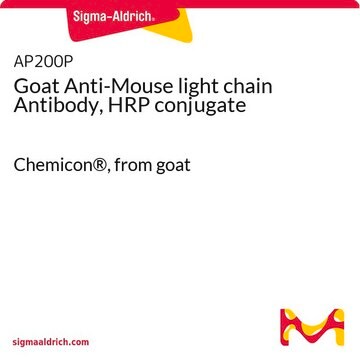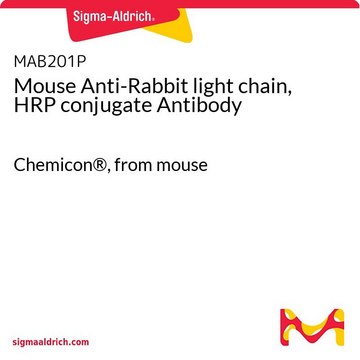MAB201
Mouse Anti-Rabbit light chain Antibody
Chemicon®, from mouse
Sign Into View Organizational & Contract Pricing
All Photos(1)
About This Item
UNSPSC Code:
12352203
eCl@ss:
32160702
NACRES:
NA.46
Recommended Products
biological source
mouse
Quality Level
conjugate
unconjugated
antibody form
ascites fluid
clone
monoclonal
species reactivity
rabbit
manufacturer/tradename
Chemicon®
technique(s)
ELISA: suitable
western blot: suitable
isotype
IgG1κ
shipped in
wet ice
target post-translational modification
unmodified
General description
Antibody molecules typically comprise two immunoglobulin light chains covalently bound to a pair of heavy chains. Immunoglobulin light chains occur in two types, designated by the Greek letters kappa and lambda. Kappa and gamma light chains are approximately 250 amino acids in length with an average mass of about 25 kDa. The ratio of kappa to lambda found in the immunoglobulin population varies by species.
Specificity
Minimal cross-reaction with bovine, goat, Armenian hamster, horse, human, mouse, rat, and sheep.
The antibody reacts strongly with native primary antibodies primarily with kappa light chains. It is not suitable for detecting lambda light chains. The antibody does not react with the heavy chain of rabbit IgG. The antibody has been tested by ELISA and adsorbed to ensure minimal cross-reaction with bovine, goat, Armenian hamster, horse, human, mouse, rat, and sheep immunoglobulins.
Immunogen
Epitope: Kappa light chain
Prepared from rabbit IgG light chain.
Application
Research Category
Secondary & Control Antibodies
Secondary & Control Antibodies
Research Sub Category
Fragment Specific Secondary Antibodies
Fragment Specific Secondary Antibodies
This Mouse anti-Rabbit light chain Antibody is validated for use in ELISA, WB for the detection of Rabbit light chain.
Target description
25 kDa
Physical form
Ascites
Isolated from ascites by chromatographic procedures. Liquid in 0.01M Sodium Phosphate, 0.25M NaCl, pH 7.6.
Storage and Stability
Maintain refrigerated at 2°-8°C under sterile conditions for up to twelve months from date of receipt. Avoid repeated freeze/thaw cycles.
Legal Information
CHEMICON is a registered trademark of Merck KGaA, Darmstadt, Germany
Disclaimer
Unless otherwise stated in our catalog or other company documentation accompanying the product(s), our products are intended for research use only and are not to be used for any other purpose, which includes but is not limited to, unauthorized commercial uses, in vitro diagnostic uses, ex vivo or in vivo therapeutic uses or any type of consumption or application to humans or animals.
Storage Class
12 - Non Combustible Liquids
wgk_germany
WGK 2
flash_point_f
Not applicable
flash_point_c
Not applicable
Certificates of Analysis (COA)
Search for Certificates of Analysis (COA) by entering the products Lot/Batch Number. Lot and Batch Numbers can be found on a product’s label following the words ‘Lot’ or ‘Batch’.
Already Own This Product?
Find documentation for the products that you have recently purchased in the Document Library.
Charles E Evans et al.
Neurobiology of aging, 75, 136-149 (2018-12-21)
β-Amyloid (Aβ) accumulation is an early event of Alzheimer's disease (AD) pathogenesis. Inhibition of Aβ production by β-secretase (BACE) has been proposed as a potential therapeutic strategy for AD. However, BACE inhibitors lack specificity and have had limited clinical benefit.
Javier Garzón-Niño et al.
International journal of molecular sciences, 24(1) (2023-01-09)
The opioid peptide β-endorphin coexists in the pituitary and brain in its αN-acetylated form, which does not bind to opioid receptors. We now report that these neuropeptides exhibited opposite effects in in vivo paradigms, in which ligands of the sigma
Michael J Tuvim et al.
The Journal of biological chemistry, 284(15), 9781-9787 (2009-02-12)
Synaptotagmin 2 (Syt2) functions as a low affinity, fast exocytic Ca(2+) sensor in neurons, where it is activated by Ca(2+) influx through voltage-gated channels. Targeted insertion of lacZ into the mouse syt2 locus reveals expression in mucin-secreting goblet cells of
Jung-Lin Wu et al.
Nature communications, 7, 12526-12526 (2016-08-25)
Crosslinking of B-cell receptor (BCR) sets off an apoptosis programme, but the underlying pathways remain obscure. Here we decipher the molecular mechanisms bridging B-cell activation and apoptosis mediated by post-translational modification (PTM). We find that O-GlcNAcase inhibition enhances B-cell activation
Our team of scientists has experience in all areas of research including Life Science, Material Science, Chemical Synthesis, Chromatography, Analytical and many others.
Contact Technical Service








